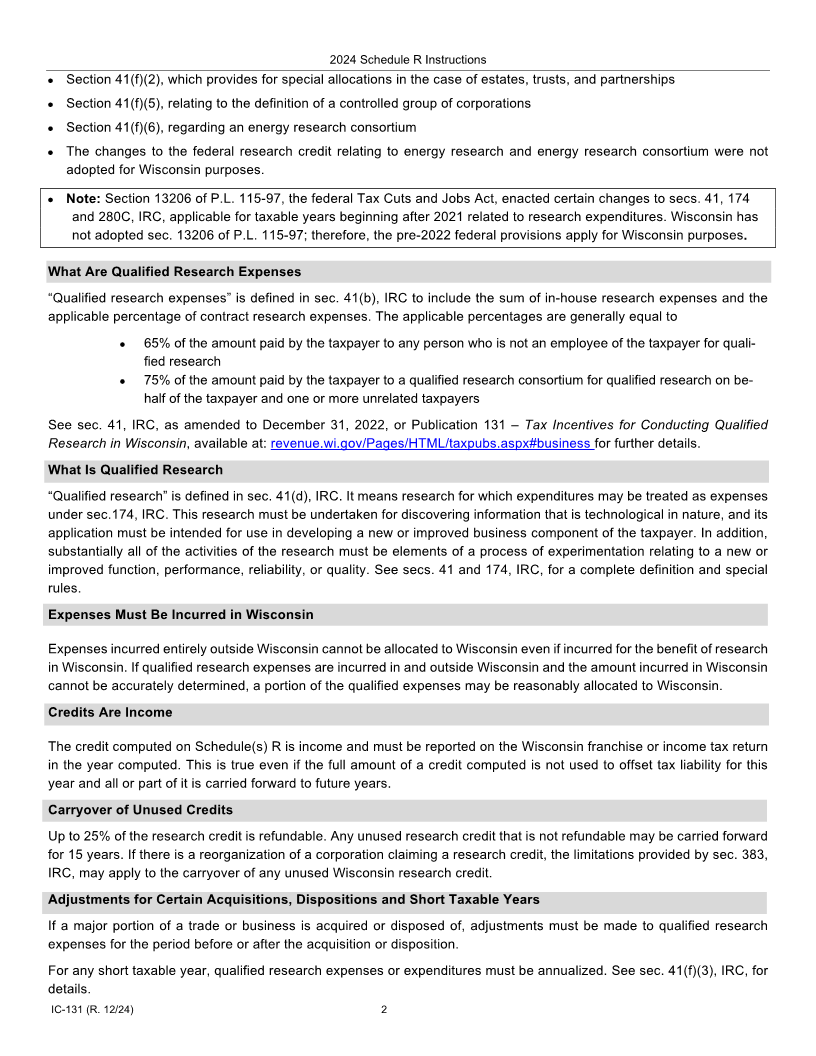
Enlarge image
Instructions for 2024 Schedule R
The Wisconsin research credit calculation is determined by Wisconsin statues, not the Internal Revenue Code (IRC).
However, Wisconsin defines which expenses are eligible to be used in the calculation of the credit by referencing sec. 41,
IRC. According to sec. 71.28(4)(ad)4.b., Wisconsin Statues, “qualified research expenses means qualified research ex-
penses as defined in section 41 of the Internal Revenue Code, except that qualified research expenses includes only ex-
penses incurred by the claimant, incurred for research conducted in this state for the taxable year and does not include
compensation used in computing the credit under sub. (1dx), the corporation's base amount. Section 41 (f) (1), (2), (5),
and (6) and (h) of the IRC does not apply to the credit under this subdivision."
Research expenses not used in the research credit calculation may reduce federal taxable income in accordance with
sec.162, 174 and 280(C), IRC, therefore the difference between the research expenses used to calculate the federal
credit and those used to calculate the Wisconsin credit may create a Wisconsin modification.
Section 13206 of P.L.115-97, the Tax Cuts and Jobs Act, enacted certain changes to the IRC applicable for tax years
beginning after 2021 related to sections 41, 174 and 280(c). Wisconsin has not adopted section 13206 of P.L.115-97.
Therefore, the pre-2022 rules remain in effect for Wisconsin purposes.
Purpose of Schedule R
Estates and trusts, partnerships, and tax-option (S) corporations use Schedule R to report the distribution of the computed
credit. Individuals, C-corporations, and tax exempt entities use Schedule R to report and claim the credits for increasing
research activities in Wisconsin.
See “Special Instructions for Combined Group Members,” page (2) of these instructions for special rules that apply
to combined group members of a corporation.
For more details on the research credit, see Publication 131 – Tax Incentives for Conducting Qualified Research in
Wisconsin, available at: revenue.wi.gov/Pages/HTML/taxpubs.aspx#business
Only include one type of research credit on a Schedule R. If more than one research credit is being claimed, use
additional Schedules R. For example, to claim the credit for increasing research expenses and the credit for activities
related to internal combustion engines, complete a separate Schedule R to compute the credit for increasing research
expenses and another Schedule R to compute the credit related to internal combustion engines.
The Schedule(s) R must be included with the Wisconsin income or franchise tax return filed by both the pass-through
entity distributing the credit and the entity owner claiming the credit.
Who Is Not Eligible
Partnerships, limited liability companies (LLCs) treated as partnerships, and tax-option (S) corporations cannot claim
research credits to be used to offset tax liability; however, the computation of, and eligibility for, the research credits are
based on the research activities conducted by those entities. The credits computed at the entity level flow through to the
partners, members, or shareholders based on their ownership interests and are claimed on their respective tax returns.
Internal Revenue Code
For purposes of computing the Wisconsin research credits, “Internal Revenue Code” means the federal Internal Revenue
Code (IRC) as amended to December 31, 2022, with certain exceptions that are explained in the Form 1, 1NPR, 2, 3, 4,
4T, 5S, or 6 instructions. Relating to the Wisconsin research credits, exceptions to the IRC include:
• Section 41(b)(3)(D)(i) which replaces the 65% in the general definition of contract research expenses with 100% for
payments to Eligible Small Businesses, Universities, and Federal Laboratories.
• Section 41(f)(1), which provides special rules for the aggregation of expenditures for a controlled group of taxpayers
filing a federal consolidated return.
IC-131 (R 12/24) 1




